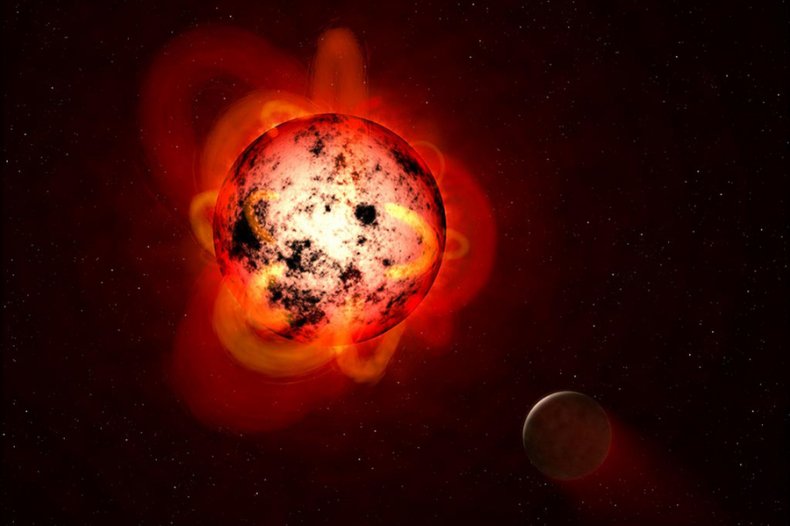Astronomers have discovered a new blisteringly hot world that whips around its star, completing an orbit in just eight hours. The planet is also remarkable because it is one of the lightest planets ever discovered outside of the solar system.
The exoplanet, located 31 light-years from the sun and designated GJ 367b, is an example of an ultra-short-period planet. These are small, compact worlds that orbit their stars at close range, with years that last less than 24 hours.
This exoplanet is so so close to its star, the red dwarf GJ 376, that it receives 500 times more radiation than Earth does from its own star, the Sun. GJ 367 b is also tidally locked, meaning that one side of the planet, its "dayside," permanently faces its star.
This results in a dayside temperature of around 2,700 degrees Fahrenheit. With these extreme temperatures, the exoplanet also seems to have lost its atmosphere some time ago.
Because it is relatively close to Earth compared to other ultra-short-period planets, astronomers were able to discover that GJ 367b is a rocky world with a solid core of iron and nickel. This core extends through almost 90 percent of the planet's interior, similar to the core of Mercury.
"We're finding a Mars-sized planet that has the composition of Mercury," principal research scientist at Massachusetts Institute of Technology (MIT), Roland Vanderspek, said. "It's among the smallest planets detected to date, and it's spinning around an M dwarf on a very tight orbit."
The discovery, detailed in a paper published in the journal Science, could help researchers learn more about how the extreme systems of ultra-short-period planets evolve.
Additionally, astronomers will be examining this system to see if GJ 367b is accompanied around its red dwarf host star by planets that could be habitable.
"For this class of star, the habitable zone would be somewhere near a month-long orbit," senior research scientist at MIT's Kavli Institute for Astrophysics and Space Research, George Ricker, said. "Since this star is so close by and so bright, we have a good chance of seeing other planets in this system.
"It's like there's a sign saying, 'Look here for extra planets!'"
The team spotted GJ 367b with the aid of NASA's Transiting Exoplanet Survey Satellite (TESS), which identifies exoplanets as they cross the face of their parent star by spotting the periodic and tiny dips in light this transit causes.
TESS has thus far proved incredibly successful in spotting exoplanets, with this transit method. As of April 2021, the NASA craft had detected over 2,200 worlds outside of the solar system.
For a month in 2019, TESS recorded an area of the sky over the southern hemisphere that included the star GJ 376. Analyzing this data, the MIT researchers and their colleagues found a transiting object with an ultra-short, eight-hour orbit.
The exoplanet was confirmed and then observed more closely with High Accuracy Radial Velocity Planet Searcher, or HARPS, attached to the ESO's 3.6m telescope at La Silla Observatory in Chile.
This instrument allowed the team to determine that GJ 376b has a radius just under three quarters that of Earth, but a mass that is just half that of our planet.
These measurements indicated to the astronomers that the exoplanet likely has an iron-rich core that makes up 86 percent of its interior. A composition that is similar to Mercury, the smallest planet in the solar system and closest to the sun.
"Understanding how these planets get so close to their host stars is a bit of a detective story," TESS team member Natalia Guerrero said. "Why is this planet missing its outer atmosphere? How did it move close in? Was this process peaceful or violent?
"Hopefully this system will give us a little more insight."

https://www.newsweek.com/astronomers-find-scorching-hot-world-year-lasts-8-hours-exoplanet-red-dwarf-tess-gj-367-b-1655832
2021-12-03 16:26:47Z
CBMiemh0dHBzOi8vd3d3Lm5ld3N3ZWVrLmNvbS9hc3Ryb25vbWVycy1maW5kLXNjb3JjaGluZy1ob3Qtd29ybGQteWVhci1sYXN0cy04LWhvdXJzLWV4b3BsYW5ldC1yZWQtZHdhcmYtdGVzcy1nai0zNjctYi0xNjU1ODMy0gGAAWh0dHBzOi8vd3d3Lm5ld3N3ZWVrLmNvbS9hc3Ryb25vbWVycy1maW5kLXNjb3JjaGluZy1ob3Qtd29ybGQteWVhci1sYXN0cy04LWhvdXJzLWV4b3BsYW5ldC1yZWQtZHdhcmYtdGVzcy1nai0zNjctYi0xNjU1ODMyP2FtcD0x
Bagikan Berita Ini















0 Response to "Astronomers Find Scorching Hot Planet Where A Year Lasts 8 Hours - Newsweek"
Post a Comment